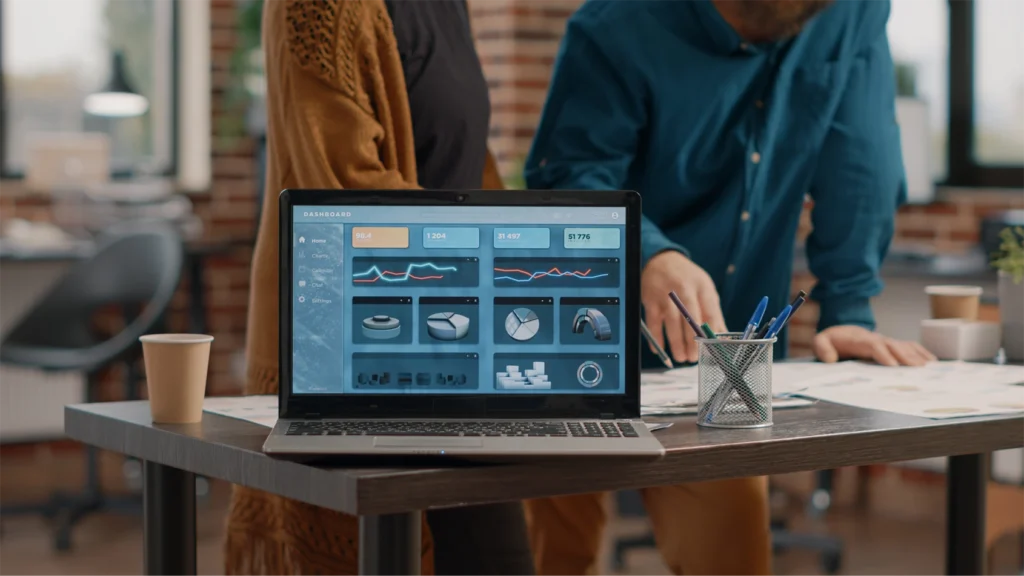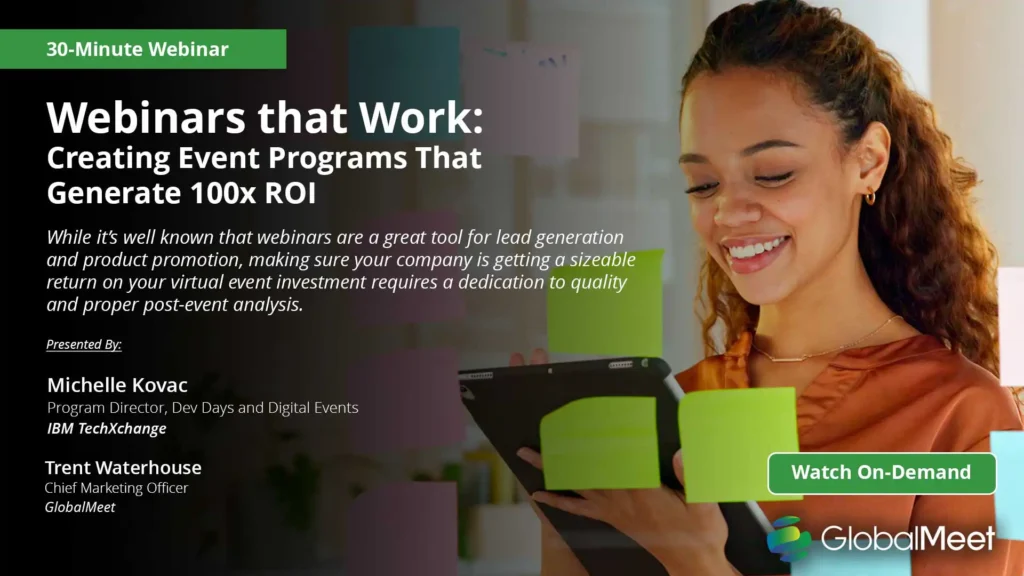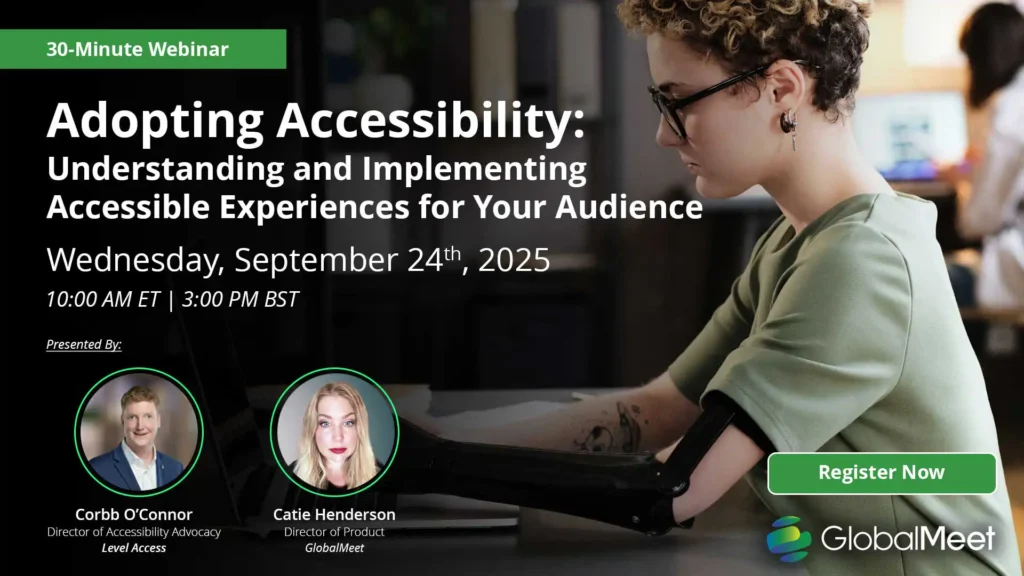
Data-Driven Event Planning: Using Analytics for Better Engagement
- by GlobalMeet Blog Team
- ,
In the age of digital transformation, where every click, comment, and connection are trackable, event planning has entered a new era. Gone are the days when event success was gauged by gut instinct and post-event applause. Today, data-driven event planning is redefining how organizers design, deliver, and evaluate events — particularly in the fast-evolving world of virtual events. With the right approach to event analytics, planners can turn raw data into meaningful insights that drive engagement, improve attendee satisfaction, and optimize outcomes.
Why Data Matters in Event Planning
Events — whether conferences, webcasts, trade shows, or networking sessions — are rich with data. Every registrant, login, and question asked contributes to a digital footprint that tells a story. When captured and analyzed effectively, this data becomes a strategic asset that can significantly improve event management by providing detailed insights into consumer behavior, which in turn enhances marketing strategies and operational efficiency.1
Data helps event planners:
- Understand attendee behavior
- Identify which sessions resonate most
- Pinpoint drop-off points during virtual events
- Tailor content and communication to audience preferences
- Make smarter decisions for future events
This depth of insight available from every single event is a powerful tool for continuous improvement, with real time analytics allowing for dynamic adjustments during events to give participants more meaningful experiences. After the event, post event data enables trend analysis that can feed into future strategic decision-making, and higher return on investment with every subsequent event.
The Shift from Intuition to Analytics
Traditionally, event planning leaned heavily on experience, anecdotal feedback, and post-event surveys. Despite 90% of event planners and marketers reporting that they still use surveys to measure the satisfaction of participants, 19% still report that they do not know their ROI for events.
While these survey inputs are valuable, they are no longer sufficient on their own. The shift to data-driven decision making represents a fundamental change in how events are planned and measured.
Instead of simply asking “Did people enjoy the keynote?”, the collection of qualitative data allows planners to explore trends in more detail. Collecting data on such items as how many attendees watched a keynote, how long they watched, how many engaged with polls or Q&As, and how they scored the session as it closed, enables the creation of measurable metrics that can be used to track improvement in every event.
An analytical approach helps organizations move from assumption to evidence, facilitating continuous improvement and allowing for better resource allocation overall.
Key Event Metrics to Track
Understanding which metrics matter most is the first step in creating a data-driven event strategy that will allow you to learn as your events grow. Creating an overarching data framework for all events where every metric is tracked and analyzed facilitates continuous improvement, with better knowledge exchange between past and future events alleviating uncertainty.2
Below are some of the most critical metrics to monitor, especially for virtual and hybrid events.
Engagement Rates
Engagement is the heartbeat of a successful event. In virtual environments, where distractions are high and attention spans short, tracking how attendees interact is essential. Common engagement indicators include:
- Chat and Q&A participation
- Poll response rates
- Number of virtual session attendances
- Social media shares and mentions
- Participation in gamification segments
High engagement suggests that content is relevant, the format is effective, and the audience is invested. Whilst low engagement provides metrics on which to improve for future events.
Session Attendance
Tracking which sessions attendees join — and for how long — offers insight into content relevance and scheduling effectiveness. Look for:
- Total session attendees
- Peak concurrent attendance
- Session drop-off rates
- Re-watch numbers for recorded sessions
These metrics can inform future content curation, and can help identify which topics or speakers drive the most interest from a target audience.
Audience Retention
Retention metrics show how well an event holds attendee attention. For example, a 60 minute session with an average watch time of 15 minutes may signal a need for a shorter format or more dynamic content delivery style.
Tracking retention can also help organize segment attendees by interest or engagement level, which opens the door to dynamic and post-event personalization.
Feedback and Sentiment
Quantitative metrics are powerful, but qualitative data — like attendee feedback — adds essential context to the mass of numbers. Gathering real-time feedback via surveys, live polls, or post-event questionnaires helps you:
- Understand attendee satisfaction
- Identify pain points
- Highlight what worked well
- Capture improvement suggestions
Some advanced platforms also use AI-driven sentiment analysis to evaluate tone and emotion in written feedback or chat logs.
Combining both data sets for meaningful analysis gives you the best insight possible into your audience, and how to better reach them.
Tools for Data-Driven Event Management
Today, state-of-the-art event technology offers a variety of platforms and tools designed specifically to capture and analyze the data that matters most to your organization at every stage of the event lifecycle.
Event Management Platforms
Specialized bespoke event management platforms are going from strength to strength when it comes to capturing and managing your event data.
Tools like GlobalMeet not only integrate into existing CRM systems, but also offer a suite of built-in analytics dashboards that track:
- Registration and attendance data
- Engagement metrics
- Conversion rates
By utilizing a powerful platform with good CRM integration, event data not only informs future events, but allows for cross collaboration between teams for broader business growth.
Audience Engagement Tools
Platforms that contain or integrate with interactive elements are an excellent resource for collecting analytics on participation rates and audience engagement. A poll, quiz, or Q&A might be easy to overlook on the surface, but the data that they provide are invaluable for understanding your audience, and connecting on a deeper level.
Marketing and CRM Integrations
Connecting event data with tools like HubSpot or Salesforce allows event planners to:
- Track attendee behavior across channels
- Score leads based on engagement
- Trigger personalized follow-ups based on session attendance or pole responses
And with many CRM systems allowing for process automation, event planners can save valuable time by making the best use of them.
AI and Predictive Analytics
Some platforms are beginning to use AI to:
- Predict which sessions will have the highest attendance
- Recommend personalized content to attendees
- Suggest optimal timing and formats based on historical data
This technology adds another layer of analytics information, helping planners stay ahead of audience expectations and mitigate potential issues before they arise.
Personalization Strategies Based on Attendee Data
One of the biggest advantages of data-driven event planning is the ability to create personalized experiences for every attendee. Rather than taking a one-size-fits-all approach, data allows planners to segment their audiences and tailor content accordingly.
Before the Event
Use registration data and past engagement history to:
- Recommend sessions or tracks
- Personalize event communications
- Match attendees with relevant networking opportunities
During the Event
Real-time engagement data enables:
- Dynamic content delivery (e.g., pop-up polls or suggested sessions)
- Customized agendas based on behavior
- Adaptive push notifications and reminders
After the Event
Post-event, data enables:
- Personalized thank-you emails
- Targeted follow-up based on session attendance
- Lead scoring for sales teams based on engagement levels
By making attendees feel seen and understood, personalization enhances satisfaction and increases the likelihood of repeat attendance.
Conclusion
As virtual and hybrid events become more sophisticated, the use of event analytics is no longer optional — it’s a competitive necessity. Planners who embrace data-driven strategies will be better equipped to:
- Prove ROI to stakeholders
- Fine-tune their content and delivery
- Create memorable experiences that resonate with their audience
Ultimately, data empowers event planners to move from reactive to proactive, from general to personalized, and from guesswork to precision. As event technology continues to evolve, the opportunities to deepen engagement through analytics will only grow.
-
Gajdošík, T. 2019. Big Data Analytics in Smart Tourism Destinations. A New Tool for Destination Management Organizations? Springer Proceedings in Business and Economics, 15–33.
-
Müller, M. 2015. The Mega-Event Syndrome: Why So Much Goes Wrong in Mega-Event Planning and What to Do About It. Journal of the American Planning Association, 81(1), 6–17.

Beyond the Event: Driving Value After Close of Play
- by GlobalMeet Blog Team
- ,
Hosting a successful event, whether virtual, hybrid, or in person, is a major achievement. From planning and execution to managing participants, the effort required to bring everything together is no small feat. But here’s the big question: What happens after the event? Too often, the focus ends with the event’s conclusion, missing the opportunity to harness the full potential of post event engagement, especially when it comes to measuring event ROI and ensuring meaningful follow-ups.
With GlobalMeet, the value of your event doesn’t end when the doors close or the webinar wraps. By leveraging powerful features like post event surveys, redirects, and an in platform editing studio, you can keep momentum alive and deliver continued returns on your investment for lasting impact. These tools are critical for event follow-up strategies that drive sustained audience engagement and optimize event outcomes.
The event may end, but the conversation doesn’t have to.
One of the biggest opportunities to engage with your audience comes immediately after the event. Attendees are still thinking about the content, the connections they’ve made, and the experience overall. Post event surveys and redirects play a crucial role in these early post-event stages.
Post Event Surveys and Redirects
These surveys allow you to capture critical insights whilst the event is still fresh in your attendees’ minds. By asking for feedback on what worked and what could improve, you’re not only gathering valuable data but also showing attendees that their opinions matter to you.
Redirects are an effortless way to guide your audience towards their next steps after the event. Whether it’s visiting a landing page with exclusive resources, signing up for upcoming sessions, or engaging in post event discussions, redirects ensure attendees remain connected to your brand.
Repurpose content with ease using our in platform editing studio
Post event the materials you’ve created — from session recordings to slide decks — represent a treasure trove of content that can be used again. But the challenge lies in editing and repurposing them effectively. This is where GlobalMeet’s in platform editing studio makes all the difference.
Adjust Without all the Hassle
Update your slide deck to correct a typo, or swap out a graph to reflect updated data, all within the platform, without downloading or requiring specialist tools. The editing studio provides a seamless way to polish your event materials so they’re always up to date and ready to share.
Repurpose for Maximum ROI:
These adjusted materials can then be repurposed into blogs, social media posts, training modules, or evergreen marketing assets. This not only extends the life of your event content, but also ensures that every resource you’ve created continues to deliver value long after the event is over, an essential part of measuring event ROI and maximizing content utility. Saving you time to work on the next big event.
Centralized insights for a seamless feedback loop
The data collected during and after your event — including attendee metrics, engagement statistics, and survey responses — offers actionable insights into what worked and where there’s room for improvement. GlobalMeet simplifies this process by consolidating all data into one place, making it easy to analyze and act on.
By identifying trends you can:
- Understand which sessions or speakers resonated most with your audience.
- Fine tune your content strategy for future events.
- Align marketing and sales efforts with audience behavior and preferences.
Use your insights to create data-driven case studies that showcase your event’s success, and leverage your data, to make sure every event is better than the last.
Continuous engagement beyond the event
The post event phase is a critical opportunity to nurture your audience relationships, and build loyalty with your customers. By integrating fully with your CRM, GlobalMeet enables you to maintain engagement through timely follow-ups and targeted communication.
Timely follow-up emails
Send personalized thank you messages, including event highlights, and invite attendees to engage with additional content or future opportunities.
Exclusive Resources
Provide access to session recordings, supplementary materials, or discounts for upcoming events.
Community Building
Encourage attendees to join social media groups, newsletters, or mailing lists to stay connected.
Strengthen your Pipleine and Plan for the Future with Post-Event Insights
For businesses, events often serve as a critical avenue for generating leads. But how you manage those leads and analyze event performance after the event can make all the difference. GlobalMeet integrates seamlessly with CRM platforms to help you qualify and nurture leads effectively, whilst capturing detailed event insights that help you understand what works well, what needs refining, and how to approach measuring event ROI effectively.
Attribution of Survey Results and Q&A Submissions
Connect survey responses and Q&A interactions to individual participants for deeper insight into attendee engagement, allowing you to optimize future events based on real time data.
Maintain a Record of Certificates Earned
Keep track of certificates earned by registrants for post-event evaluation and continued professional development.
Track Viewing Duration Per Registrant
Analyze how long each attendee engaged with event content to gauge interest and participation levels, improving your lead scoring by identifying engagement, so you can be sure of their focus in future events.
CRM Campaign Tracking
Record which campaign links a registrant used to analyze the most effective lead sources and associate registrants with specific CRM campaigns, ensuring that you know where to put your campaigning energy.
Event Resources and CRM Integration
Link event resources with CRM-Tracked collateral, enabling more effective follow-ups and content engagement tracking, delivering personalized post-event outreach that aligns with attendee behavior.
Conclusion
The end of an event isn’t a stopping point; it’s a springboard for continued engagement and growth. With engagement-focused features, robust analytics for measuring event ROI, and an intuitive editing studio, GlobalMeet gives you the tools to maximize the value of every event.
From turning insights into future successes, to building long term relationships with your customers, the tools at your disposal make it possible to elevate your events from one off experiences to integral components of your marketing and event follow-up strategies, ensuring every event drives lasting impact and stronger connections.

How to Create a High-Performing Video Marketing Campaign
- by GlobalMeet Blog Team
- ,
Amidst tightening consumer budgets, economic volatility, and general uncertainty, marketers in the financial sector have to do more with less. Ad dollars must stretch farther, content needs to be re-purposed multiple times, and teams are embracing scrappier video production methods over expensive studio production. The average corporate marketing video, as part of a video marketing campaign, can cost anywhere from $2,000 to $7,000 to produce, and quite often, costs tend to go up into the tens of thousands. Twenty-two percent of marketers are creating a few videos a week, but with the promising results and success stories around video, that number will continue to increase.
Also, video is wildly successful across social media; organic social video gets 1,200% more shares than text and images alone, and 87% of marketers believe video generates a positive ROI. For marketing and social media teams looking to take their content strategy to the next level, here are a few tips on scaling content creation.
1. Empower Teams to Produce Content Independently
When 51% of marketers are still relying on internal teams to produce video content, it takes forever. Between multiple rounds of revisions, editing, and formal storyboarding, the process is dragged out and outdated. Encourage teams to spend a few hours a week brainstorming content ideas and then quickly putting those ideas into action through effective corporate video marketing strategies. Whether it’s educational content like “3 Ways to Save for Retirement” or informative like a market update, get teams empowered to be their own writer, producer, and editor for effective corporate video marketing.
2. Host Webcasts
Long-form videos like webcasts can keep customers and strategic partners highly engaged when done right. Whether on-demand or live, webcast platforms offer tons of different ways to engage your audience before, during, and after the event. Start the branded experience with on-brand content portals from GlobalMeet and create interactive polls and surveys for engagement during the webcast. Wrap up your successful webcast by integrating GlobalMeet with your go-to marketing, sales, CRM, and email automation platforms to provide critical attendee information to your other teams.
3. Test Live, Simulated Live, and Pre-Recorded Video
When you’re starting a new video strategy, you might not be sure exactly what resonates with your audience. Do they enjoy a long-form webcast at a specific time? Are they more willing to engage with financial advisor updates when they’re on demand? Experiment with different formats and styles to see what content dissemination strategy works best for you.
4. Streamline Your Workflow
From idea creation to editing to sharing across social media or your website, simplify all aspects of your video creation workflow. Obtain buy-in from leadership so your marketing team doesn’t need to run every single revision across the executive team. Employees will feel confident in being authentic, and production times can decrease. Minimize the number of technology apps used to create a single video.
Video Creation Across the Financial Services Sector
Video adoption has transformed multiple industries, and the financial sector is no exception. As marketers are forced to do more with less, reducing costs, decreasing product times, and accelerating content schedules are critical in maintaining a high-performing video content calendar. Contact our sales team to learn more about how financial services teams are adopting and scaling impactful video marketing campaigns.

7 Webcast Marketing Strategies
- by GlobalMeet Blog Team
- ,
Ready to get the word out about your next press conference, investors meeting, or an informative event for lead generation? It’s a noisy online world, and virtual events quickly get lost in the shuffle without a solid webcast marketing strategy.
From spreading the word through email marketing and public relations outreach to ensuring proper follow-up nurture with attendees, webcast marketing is most effective when you implement a variety of strategies across the entire journey. Leverage some of the below marketing webcasts tactics along with real-world promotions for the best results.
Also, don’t forget to closely track conversion rates, open rates, impressions, sales, and more along the various marketing channels. This will help evaluate the success of your marketing campaigns in driving awareness and, ultimately, generating more revenue.
1. Marketing Webcasts: Warm Email Marketing
While some consider email marketing “old school,” it’s still one of the most direct ways to reach consumers. While 99% of people open their emails every day, the average person also receives an average of 121 emails per day. Your email marketing strategy must be sophisticated and personalized, which helps you avoid the dreaded “delete button.”
Segment your list into specific audiences (think customers, prospects, partners, and more) to generate engaging content specifically suited to their needs. Kick off your email marketing roughly two weeks before the webcast and increase the email frequency as the day and time get closer.
2. Social Media Advertising (Paid and Organic)
Utilizing hashtags, emojis, posting consistently, and leveraging the power of the algorithm on top social networks is another effective strategy for getting your webcasts in front of the right audience. Use a specific hashtag to create a branded experience around your event and help potential attendees find more information. Also, don’t forget to constantly include a link to the registration page.
Once you’ve determined the types of posts and graphics that perform best, consider putting some ad spend behind that winning content. Social media ads are often more effective than other forms of advertising, and 72% of marketers regularly use paid ads.
3. Display Ads
Display ads are excellent ways to drive top-of-funnel awareness. When consumers constantly see your webcast advertised on third-party websites, on Google, or in other apps, they’re reminded to sign up for your event. The “Marketing Rule of 7” states that people need to hear about something at least seven times before they consider taking action, and display ads are an excellent way to increase the frequency of your drumbeat.
4. Content Marketing
With 70% of consumers preferring content marketing to traditional marketing, its vital to utilize this element in getting the word out about your webcast. Content marketing can range from long-form to short-form content or even simple repurposing of social or email content. Blog posts drive traffic to your website, and with the right keywords, your content marketing efforts can drive you to the top of Google search results. Over 25% of people click on the first Google search result, so making sure your events rank highly is important.
5. Partnership Marketing
Are you having well-known thought leaders speak at your event? Tap into their powerful network to broaden your reach and bring their audience into your webcast. Hand them a speaker’s media kit with graphics, digital flyers, pre-written social content, and other assets to make it easy for them to share.
6. Public Relations
Public relations can be as simple or complex as time and budget allow; craft a newsworthy press release and send it out on the wire for some extra visibility. You can also reach out to reporters and journalists who cover webcasts and other virtual events in your industry and offer them a compelling statistic or insight to write about.
7. Follow-up Marketing
Once the event is over, you still want to engage with these attendees. Make sure you gather the appropriate permissions to continue follow-up on other events and future webcasts. The marketing consent tracking tool in GlobalMeet helps you share privacy policies and terms of service and allows attendees to opt-in to hear from you in the future.
Market Your Webcast with GlobalMeet
Whether you’re reaching 50 people or 100,000+ attendees, GlobalMeet Webcast is here to power your successful virtual events strategy. With custom branding opportunities, attendee engagement tools, and robust analytics, GlobalMeet makes virtual events a key pillar in your webcast marketing strategy.
Check our checklist for promoting your events and contact us for a demo today.

3 Best Practices for Driving Inbound Leads in 2023
- by GlobalMeet Blog Team
- ,
Inbound marketing is one of the most powerful marketing levers to pull in your business. Inbound marketing involves crafting high-quality, targeted content that attracts your ideal audience and builds a long-term relationship with them. This might be an annual e-book that is free to download once an email address is given or an on-demand video series. On the opposite hand, outbound marketing involves proactively reaching out to a customer through paid advertising or direct sales messages.
The Benefits of Inbound Marketing
Businesses love inbound marketing for various reasons; first of all, the ROI is high, and companies can see a solid return. Also, there are tons of automation platforms to make inbound marketing “always on” and easy. 76% of companies use some sort of automation to streamline, increase efficiency, and automate manual, repetitive tasks. Additionally, inbound marketing brings the customer to the business, allowing them to interact on the website, sign up for free downloads, register for online events, and more. It captures the audience in the content marketing flywheel and increases the frequency of exposure to the company.
When executed with a strong plan in place, inbound marketing can be one of the most profitable tools for your business. If you’re looking to polish up your inbound strategies, here are a few tips.
Best Practices for Driving Inbound Leads
1. Host a Variety of Webcasts
Webcasts help you attract, nurture, and retain customers cost-effectively and efficiently. A well-planned virtual events calendar throughout the year is constantly peppered with relevant educational topics your audience is interested in. For 45 minutes to an hour, attendees are actively engaged with your company, brand, and message. In the digital world, that’s a long time! When the average person only reads about 20% of a webpage or a blog post, capturing undivided attention for an hour is highly beneficial. Experiment with the format and style with an innovative webcast solution like GlobalMeet Webcast to see what resonates best with your audience.
2. Increase SEO Presence
SEO is one of the most significant drivers of inbound leads and revenue; after all, these are highly qualified, ready-to-buy users who are actively searching for a business or product like yours. 91% of businesses find SEO “very profitable,” so make sure your top-ranked pages include clear call-to-actions to demo or buy.
3. Repurpose Video Content
Video content is often long-form and requires more intensive work in editing and production; that being said, don’t just use a video once. If your business hosts an hour-long webcast, chop that up into digestible 10-minute videos and host them behind a gated form. Repurpose them into email nurture content or a welcome sequence when someone signs up for your newsletter. You can even re-post them on social media like LinkedIn or YouTube. Extend the shelf life of your webcasts by analyzing audience engagement metrics to see what topics resonated best with your audience, and dive deeper into those niches in new content down the road.
GlobalMeet Webcast for Inbound Marketing
Webcasts and videos are one of the most popular tools in inbound marketing, and an innovative webcast solution is critical to getting a virtual event strategy off the ground. GlobalMeet Webcast allows you to dive deep into robust analytics to measure your webcast’s effectiveness and helps you extend the shelf life of your content by creating on-demand recordings. For global inbound marketing, utilize live event translations and captioning to increase accessibility, and rest assured, knowing your inbound marketing webcast strategy is working when you’re not. Schedule a demo today to learn more.


